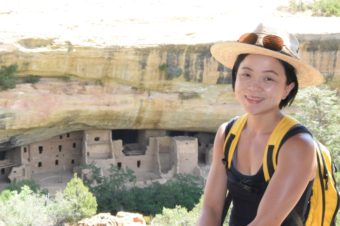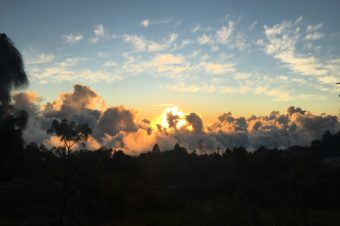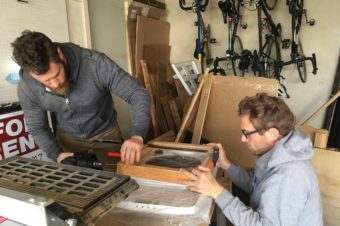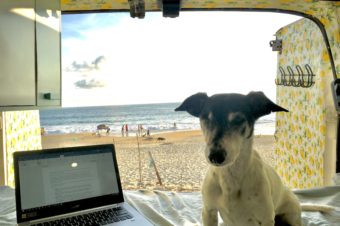Mexico’s El Día de la Revolución (The Day of the Revolution) is a national holiday commemorating the beginning of the Mexican Revolution that began in 1910 and lasted for ten years of political and social conflict.
When it is:
Revolution Day is celebrated every year on November 20th, when parades and civic ceremonies celebrate this momentous part of history.
Revolution Day weekend is always the third weekend in November, when the streets are filled with pedestrians shopping, sightseeing, and dining out.
Why read this:
In this article, I’ll give you some historical context and I’ll provide suggestions on what to do in Mexico City over the three-day weekend and on Revolution Day itself.
History & Context
If you know this blog, you know I can’t let you move forward without some context! This national holiday is incredibly important to Mexicans, and I think it’s only respectful that we, as tourists, make an effort to understand the story and its significance to Mexico.
El Día de la Revolución commemorates the revolt that occurred on November 20th, 1910, that led to the overthrow of President Porfirio Diaz after three decades in office.
President Porfirio Diaz
Porfirio Diaz was President of Mexico for 30 years – a long and very productive term that is today very controversial. Depending on the source of information, the story of his presidency can vary widely.
To some, he was known for economic development, technical progress, and modernization. He was a military hero and a pragmatic politician who brought forth foreign investments, developed industry and infrastructure, and created an effective centralized government.
To others, Diaz’s presidency was also criticized for authoritarian rule, corruption, and high poverty. He made the rich richer and the poor poorer. He suppressed public revolts with military force and dispossessed peasants and rural farmers.
In much of Mexico City, you will still find his name and face on statues, paintings, buildings, and streets. However, at the same time, Mexicans celebrate and commemorate the success of the Mexican Revolution and the day that Diaz was ousted into exile.
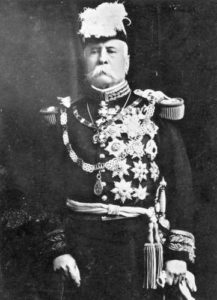
Francisco I. Madero
Francisco I. Madero was a wealthy landowner and reformist writer. He objected to Diaz’s sixth re-election and urged for a democratic Mexico. Despite having limited political experience, he had the private funding to sponsor the Anti-Reelectionist Party. On this platform, he ran for President against Porfirio Diaz.
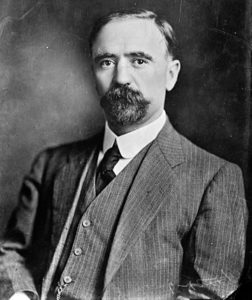
Diaz won the 1910 election, and Madero was arrested and jailed in San Luis Potosí. Released on bond, Madero escaped to Texas where he wrote the “Plan of San Luis Potosí.” In it, he rejects the outcome of the election, declares himself President, and implores Mexicans to engage in an armed revolt against Díaz.
November 20th, 1910
Madero’s Plan of San Luis Potosí called for the armed revolution to begin on November 20, 1910.
While the day itself was not especially eventful in the context of the 10-year revolution, November 20th would still become the venerated date in Mexican history.
Outcomes of the Revolution
Diaz accepted defeat and resigned on May 25, 1911. He exiled himself to Paris, where he spent the rest of his life. Madero became President in the election of November 1911, but served for less than two years. He was forced to resign in February 1913, and assassinated shortly afterward.
The revolution would go on for ten years of power struggles, political unrest, and social change.

After ten years of political and social unrest, the revolution ended in 1920 with the election of President Álvaro Obregón. Obregón is attributed with the first stable presidency after so many years of conflict.
The Three-Day Weekend
I hope you’re ready to do some walking, because you know what a three-day weekend means: lots of tourism, lots of people, and lots of shopping!
This weekend, tourists and residents alike pour out into the city streets, markets, museums, plazas, parks, and restaurants. Yes, even more so than normal!
Walking Tour – Ideal Day: Sunday
Walking is a national pastime in Mexico City. It’s especially fun and crazy chaotic on a holiday weekend, when you’re joined by millions of bobbing heads and the sights, sounds, and smells of Mexico City come alive.
Here’s what I recommend for a perfect Sunday around the city center. Use the Walking Tour Map below that I made just for you!
Start: Walk, Jog, Rollerblade, or Bicycle the Paseo de la Reforma toward Downtown
The Paseo de la Reforma is a wide avenue that runs diagonally through the heart of Mexico City, connecting Chapultepec Park to the Palace of Fine Arts (Palacio de las Bellas Artes) in downtown.
Every Sunday between 8 am to 2 pm, the main lanes of the street are closed off to vehicles. Cyclists, runners, and rollerbladers dominate the street, and motorists are relegated to the bus lane. Even when it’s not a holiday weekend, thousands of local residents and tourists participate in this open space.
What you can do along the Paseo de Reforma:
- Choose your form of transportation. Bicycle rentals are available at several booths, with your ID as a deposit. The booths are usually set up in the middle of the intersection.
- Jump into the Zumba class. It’s free and goes on from 9 am to 1:30 pm; look for the large stage by Glorieta de la Palma. There are hundreds of participants; duck in and out as you choose.
- Get some bicycle maintenance help at any of the bike tech booths.
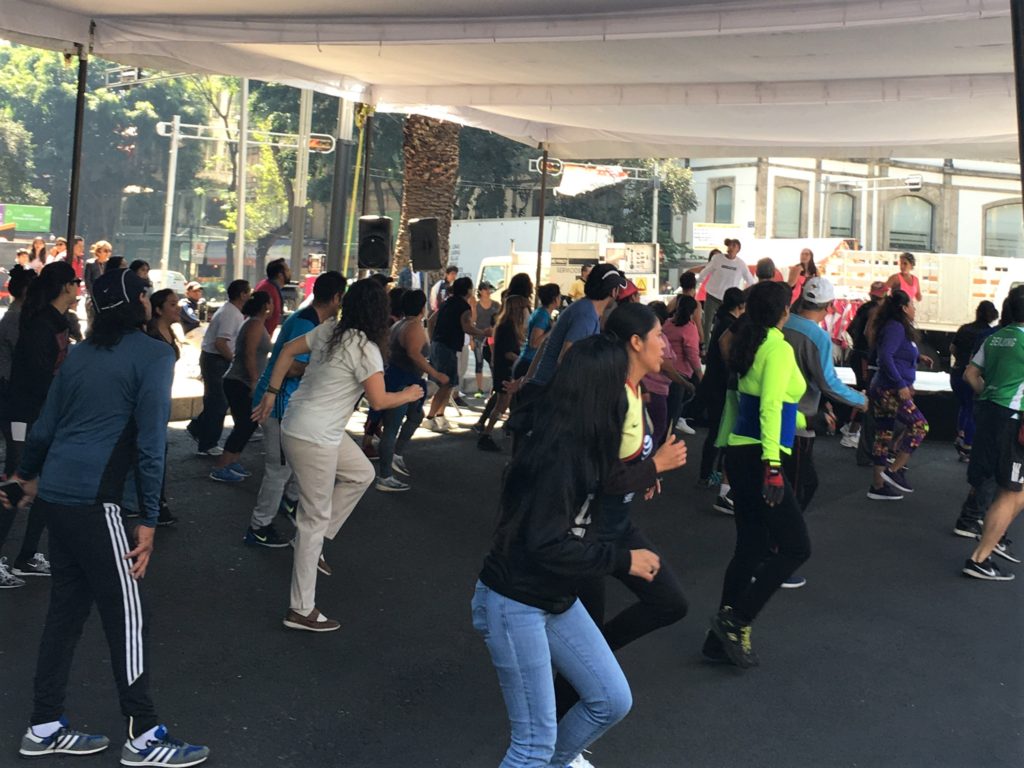
Heading north on Paseo de la Reforma, it will get busier and louder as you get closer to the city center.
Next: Sights Along Avenida Juárez
Veer right at Avenida Juárez to continue northeastward toward Zócalo Plaza.
Along the way, you’ll pass:
- Plaza de la Solidaridad, a pop-up market of trinkets, household goods, and street foods. Half of the market turns into a makeshift dance floor in the afternoon!
- Alameda Central, said to be the oldest public park in the Americas (it opened back in 1592). You certainly wouldn’t know it today though; this lovely, shaded park has been beautifully updated over time with marble paths, huge trees, light posts, fountains, benches. It takes imagination to realize that 500 years ago, this was an Aztec marketplace. Note that dogs are not allowed in, and unlike other parks in Mexico, they enforce it here.
- Palacio de las Bellas Artes, Mexico City’s premier concert hall and world-famous art museum. While you can explore the ground floor and admire the interior without a ticket, I recommend coming back on a weekday if you want to see the art museum on the 2nd Sundays are free for local residents, and the line gets very, very long. But before you move on, notice how the right side of the Palacio (if you’re facing it) is several feet below street level. About 80 years ago, the Palacio was once level with the street. This is just one visual example of how several buildings in Mexico City are sinking, about 40 centimeters per year.
- La Nacional is a big office building across the street from the Palacio. There are two towers, with a shorter annex in the middle. If you look in between the left tower and the annex, you’ll see an off-colored, slim triangle of material. This wedge was inserted to hide the slight tilt in the tower, which occurred as a result of the 1985 earthquake that destroyed over 400 buildings and killed at least 5,000 people.
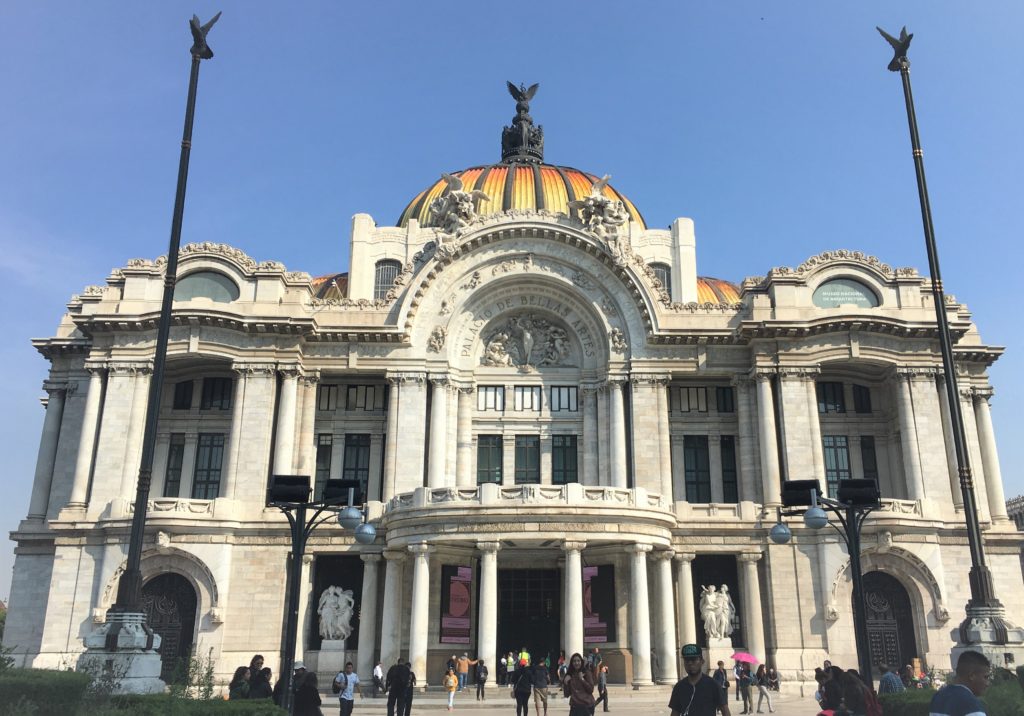
Next: El Zócalo and surroundings
Continue east toward El Zócalo. You’ll start to see the hordes condense. If you haven’t already, make sure your belongings are securely tucked away. Pedestrian traffic gets shoulder-to-shoulder from here on, so get ready!
Sights to see:
- El Zócalo is the main square in Mexico City, a must-visit for any tourist. Its real name is Plaza de la Constitución, but everyone calls it Zó This square is popularly used for mass demonstrations, concerts, shows, and civic ceremonies – as it will be on November 20th! There is usually an exhibit or two in this massive square that is worth a perusal.
- The Metropolitan Cathedral is on the north side of Zócalo. It’s a beautiful structure that has played a significant role in Mexico’s history. You can peek your head in, but there is usually mass on Sundays. To be respectful, save your thorough walkthrough for a weekday.
- Palacio Nacional (the presidential palace) lies on the east side of Zócalo. It is free to enter, and contains several famous Diego Rivera murals. Above the center door of the palace hangs the Campana de Dolores. This was the bell rung in the town of Dolores Hidalgo in 1810, at the start of the War of Independence from Spain (the other revolutionary war in Mexico’s history).
- Templo Mayor is just east of the cathedral. This ancient site is what remains of the seven-layered, four-sided temple built long ago by the Mexica, or Aztec, peoples. Before the arrival of the Spanish, what is today Mexico City used to be called Tenochtitlán, the “center of the universe,” according to the Mexica. When the Spanish conquered Tenochtitlán, they sacked the temple of its valuables and reused its stones to erect several Spanish buildings, including the buildings that you see from the Zócalo. Only the bases of the temples were left intact. Recent archaeological excavation has led to many interesting findings. As with other museums, this site gets very busy on Sundays. Save a thorough exploration for another day (hint: I recommend visiting this on Revolution Day, immediately before or after the parade). For today, use the elevated walkways to give you a glimpse of what all the fuss is about.
- Conchero or Aztec Dancers can be found wandering throughout the plaza, but they seem to be concentrated in the area between the cathedral and Templo Mayor. You can’t miss ‘em – they wear elaborately feathered headdresses, snakeskin loincloths, and accessories made of shells, seeds, skulls, and other symbolic materials.
- Some are there to perform the Conchero, a traditional dance and ceremony practiced as a form of public worship. A keen eye will notice slight variations in the dance steps, instruments, and costumes used by each group, a result of centuries of cultural adaptation. Given that this area around the Zócalo was once considered sacred, the “center of the universe,” to the Mexicas (Aztecs), today the Mexica groups consider their constant presence as a political statement of resilience and heritage.
- Others are there to perform cleansing rituals, burning smoky copal plants as incense to ward off the mal de ojo, or “evil eye.” For the folks who believe in it, the mal de ojo is caused when one person looks upon another with jealousy, often disguised as compliments or admiration. The recipient of the admiration is then cursed with illness and needs to be cleansed of the evil eye. Though it looks like a tourist gimmick, notice that the majority of those who ask for a cleansing are Mexicans, for whom the mal de ojo is more than a superstition.
- Still others are there as a cultural spectacle, charging for photo-ops. And why not? They look amazing!
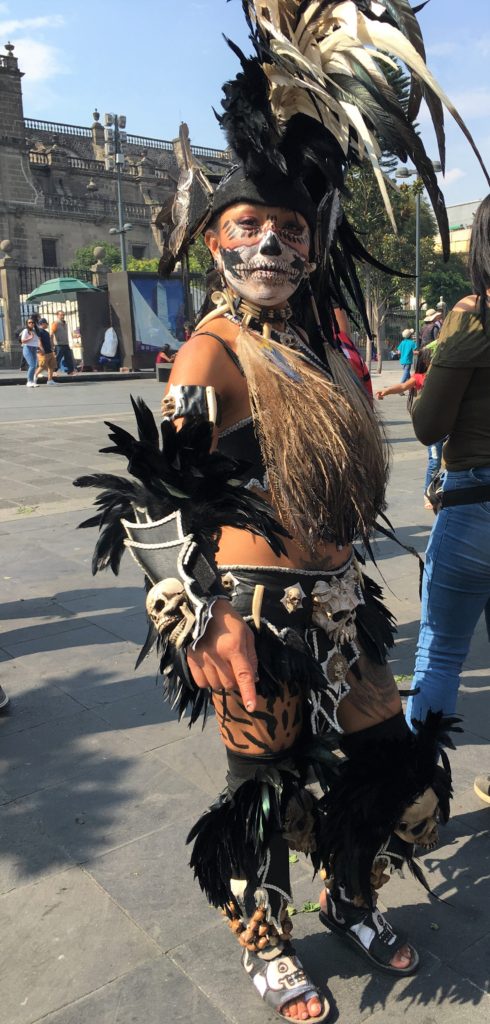
Last: Street Markets & Street Food
If you’ve stuck with me so far, you must be hungry after all that walking and sightseeing!
Not to worry; just around the corner is a huge street market that sprawls for what feels like miles in every direction. The market is so widespread, it doesn’t matter where you are coming from – just head east.
Disclaimer: The deeper (eastward) you get into this market, the further out of the tourist zone you will be. It can be overwhelming, claustrophobic, or simply too chaotic for some people. When locals hear that we’re going here, every single person warns us about pickpockets.
- Option 1: If you just want to dip your toes in, explore the first couple blocks and turn around when it gets to be too much. Also, see the next section, El Buen Fin Shopping.
- Option 2: If you like going off the beaten track, if you like being the only “Gringo” or “Chinita” around, then wandering the market on this crazy, packed weekend will be a big adventure full of bargains and delicious surprises!
Ready to explore? Here are some things you need to know:
- You can buy almost any merchandise you need here: clothes, accessories, shoes, toys, electronics, home supplies, etc. We came with a shopping list and got everything we needed plus more. Bring backpacks. Some vendors sell large reusable bags for 2-3 pesos each.
- Dining options are scattered about, so wander around till something gets your attention. When it’s busy, it’s easy to tell which vendors are favored by locals. Follow the crowds for a tastier (and safer) meal.
- Some sections of the market follow the traditional stall set up, with tents and aisles and tables displaying merchandise. Other sections are street-side picnic-style, with vendors setting up their merchandise on blankets, anywhere and everywhere that there is floor space and enough foot traffic.
- Periodically, you’ll see unlicensed vendors pack up with sudden speed and deftness; it just means they got word that the police are coming around. They’ll be back as soon as the police leave. It’s actually quite heartbreaking to see the police seize a vendor’s merchandise.
- Remember: Be alert and aware of your belongings, and trust your intuition. Aside from that, embrace the pros and cons of the street market!

On this three-day weekend, the lines between different markets blur. What’s in a name, anyway? Just keep exploring the markets in any direction until you want to route yourself home.
I hope you enjoyed this walking tour!
El Buen Fin Shopping – Ideal Day: Any
This particular three-day weekend is also associated with el Buen Fin – “the good end,” (as in the weekend). Stores advertise huge sales, similar to Black Friday in the United States. Look for the giant red signs advertising el Buen Fin.
If you’re not keen on street markets (the last stop in the walking tour, above), this Buen Fin sale is a great time to shop at the brick and mortar stores.
I picked up a great pair of boots on sale for 220 MXN, or $11 USD. We also noticed a line around the block for the Nike store. Like in the U.S., people seem to save their big purchases for this special weekend.
Visiting Museums – Ideal Day: Saturday or Revolution Day
Mexico City has over 150 museums, which makes it second only to London. Even with so many museums to choose from, the bulk of the traffic will center around the city’s major museums. Mexico City is also famous for its queues, and this weekend, wait times for museums do not disappoint (or, rather, they do?).
On Sundays, many museums are free for Mexican residents, so you can expect a much higher attendance. On Mondays, most museums are closed.
Here are our recommendations, in order, of how to make the best of your Mexico City museum experience:
#1: If possible, avoid going to museums this weekend.
Go the Friday before or the Tuesday after. The majority of museums are closed on Mondays.
This is especially true if the museum is small, like the Frida Kahlo Museum. It’s difficult just to find standing space, not to mention a good view.
DangGoodLife Tip: If you’re not interested in seeing the Revolution Day show or parade, it’s a great time to check out a museum instead, as long as November 20th doesn’t fall on a Monday. Everyone else will be checking out the parade, giving you some peace. Or, go immediately before or after the parade. I went to Templo Mayor towards the end of the parade, and I practically had the whole place to myself.
#2: If you must see a museum this weekend, go on Saturday and buy your ticket in advance or go with a tour.
The museums will still be jam-packed on Saturday, but at least you can avoid the really long taquilla (ticket office) queues.
The only museum that allows purchasing your tickets online in advance is the Frida Kahlo Museum. Also called Casa Azul, this house-turned-museum showcases the life and art collection of legendary Mexican artist Frida Kahlo. The space is small and a limited number of tickets are sold for each time slot. Book well in advance to ensure you have a ticket. The museum is located in Coyoacán, about 45 minutes south of the city center, so leave a buffer to arrive on time. Buy tickets here.

Another option is to go as part of a tour. While this is more expensive, you do get the benefit of an informed tour guide. Some exhibits and even entire museums are only in Spanish, so if you’d like a good understanding of the material, a tour is highly recommended. In your shopping for a tour, make sure that the tour company handles the purchasing of tickets.
#3: Go to the museum as early as possible.
Especially on weekends, Mexico City enjoys a pretty late start to the day.
Arrive at the museum as early as possible to avoid queues and experience the museum in relative peace and free movement. It usually gets very busy from noon onward.
#4: Choose a less-visited museum.
Be different and choose among many of the less-visited museums. Here are a couple ideas:
- Dolores Olmedo Museum – If you want to see artwork by Frida Kahlo and Diego Rivera, visit the Dolores Olmedo Museum. The museum is surrounded by lush gardens, inhabited by peacocks and hairless Xoloiztcuintle dogs, and displays hundreds of sculptural, archaeological, and international pieces. The museum is located in Xochimilco, in the far southern end of Mexico City.
- National Art Museum (Museo Nacional de Artes) – If you love art but the Palace of Fine Arts (Palacio de Bellas Artes) is just too busy, try the nearby National Art Museum (Museo Nacional de Artes). This museum houses art of various mediums and periods in the former Palace of Communications building. The architectural design is grand, eclectic, and beautiful.
- House of Leon Trotsky Museum – Yes, as in the Soviet revolutionary and former leader of another key revolution from across the globe. After Stalin condemned him to death in 1929, Trotsky eventually found refuge in Mexico in 1937. He lived with fellow communists Frida Kahlo and Diego Rivera before moving into this home in Coyoacan. In this home-turned-museum, Trotsky was assassinated by an agent sent by Stalin. His tomb and ashes today lay in the patio.
- Museum of Ancient Toys (Museo del Juguete Antiguo) – This quirky museum is a walk down memory lane. The immense and varied collection of toys belonged to Roberto Shimizu Kinoshita, who saved and collected for over seven decades. It is eccentricity at its best, especially if you’re tired of the same old museums about art, history, and nationalism.
Revolution Day – November 20th
DangGoodLife Note: the following is based on my experience in 2019. Events may change in subsequent years.
In Mexico City, El Día de la Revolución is celebrated with a presentation at Zócalo Plaza, followed by a parade that goes from Palacio Nacional to the military base at Campo Marte.
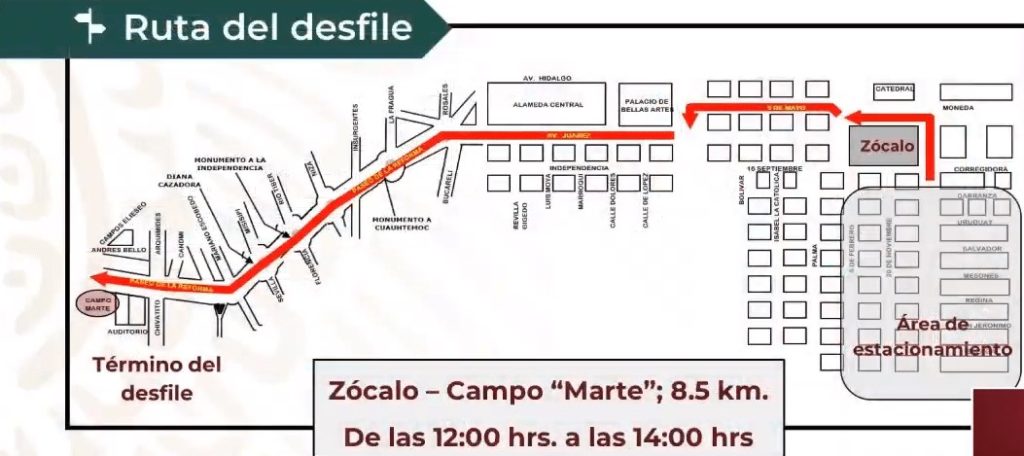
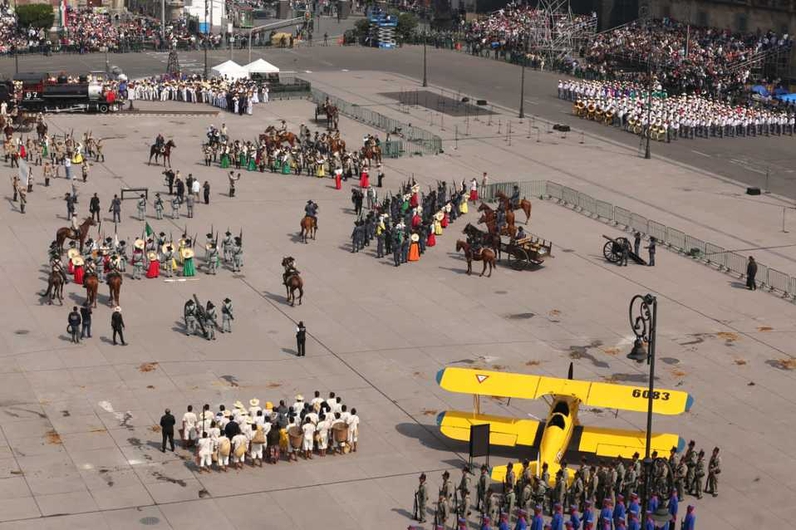
The presentation at Zócalo Plaza
- What: In 2019, the presentation was a re-enactment of Mexico’s history, with special emphasis on the Mexican Revolution. There were gunshots, cannons, fireworks, and 130 actors with clothing, tools, and even vehicles representing the different periods of Mexico’s history. In between the re-enactment and the parade, there was a short concert and a performance of acrobatic equestrians.
- When: In 2019, the presentation began at 11 am on November 20th.
- Where: In Zócalo Plaza. The presentation largely faces Palacio Nacional, where the current President views the spectacle from one of the balconies. For all other spectators, several giant screens project the action 360 degrees.
- How to See It: For the best views and closest access, get here as early as possible, much earlier than you would for any random spot along the parade route. For the best view, get a spot in front of Palacio Nacional. But really, you can watch the presentation from practically anywhere – as long as you can get a view of the Zó People sit and stand on the streets, or they watch from windows and rooftop terraces (talk to any of the promoters on the street). There are also bleachers set up in front of the Cathedral.
DangGoodLife Note: Full disclosure, I was almost trampled trying to reach the bleachers in front of the Cathedral. When I arrived around 10 am, I was told you needed a special ticket for the bleachers. For those without tickets, they would be opening up the barriers before the show began. At about 10:45 am, they slowly let people pass through the barriers. The crowd started pushing, and the folks in the front (me included) got squished. I nearly lost my footing, with my 5’0 tall, 100-pound frame. Children were crying, mothers were screaming, and people were yelling all sorts of pleas and demands amongst the anxious crowd. Eventually, I got ejected forward through the barriers like toothpaste from a tube. It was not an experience I’d like to repeat, but I did get myself a comfortable seat on the bleachers. If you attempt this, I wish you luck!
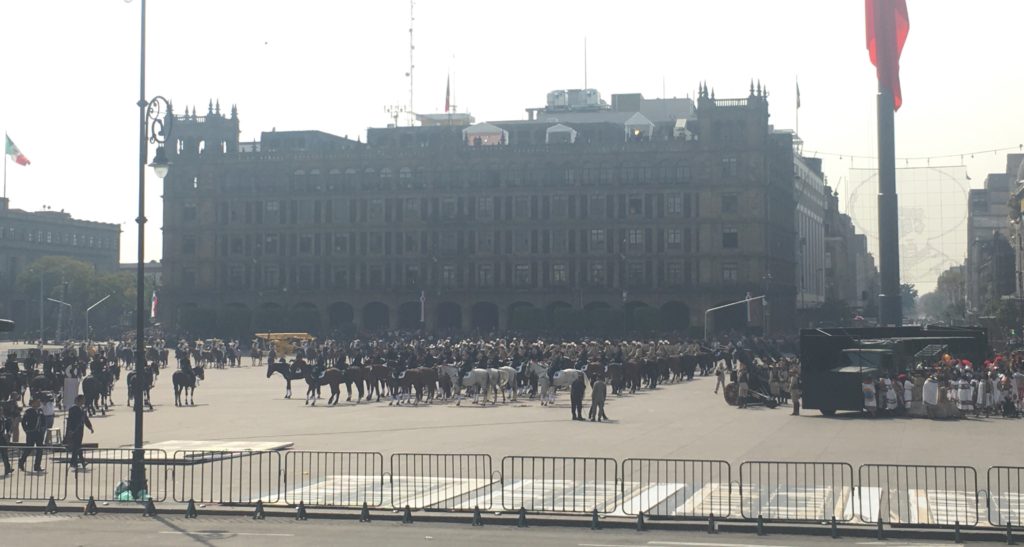
The Desfile (Parade)
- What: In 2019, the parade was billed as a historical, educational, and cultural parade about the Mexican Revolution. It consisted of 2,700 horses and equestrians, dozens of floats, an old train, and thousands of uniformed and costumed people. The floats represented different Mexican cities and states and momentous events in Mexico’s history; overall, it was indeed a very historical, educational, and cultural experience for all.
- When: In 2019, the parade went from 12 pm to 2 pm on November 20th.
- Where: Stake out a spot anywhere along the parade route from the Zócalo to Campo Marte. This route doesn’t seem to change much – see the map of 2019’s route above. Crowd attendance is much denser in the downtown area.
- How to See It: You can see the parade from where it begins in the Zócalo, or anywhere along the parade route.
- From the Zócalo: If you came to see the presentation, you will likely watch the parade here too. The parade route only goes through one corner of Zócalo plaza. If you’re stationed in front of Palacio Nacional, that is the #1 spot. If you’re on the bleachers, that’s the #2 spot. If you’re anywhere else on the perimeter, after they clear the Zócalo of people, horses, and debris, you will need to move. And I mean move. From my spot on the bleachers, once they opened up the plaza, I witnessed a horde of people running – sprinting – to claim a good spot on the other side of the barricades. The barricades filled up within minutes. On the bright side, pictures from that side of the street will not be backlit, like they are from my side of the parade route.
- Along the Parade Route: This is way easier to achieve, if you don’t want to venture toward the Zó Claiming a spot two hours before the parade is reasonable. You can always come early to scope out the crowd and then duck into a small museum or café as you monitor the crowd’s size.
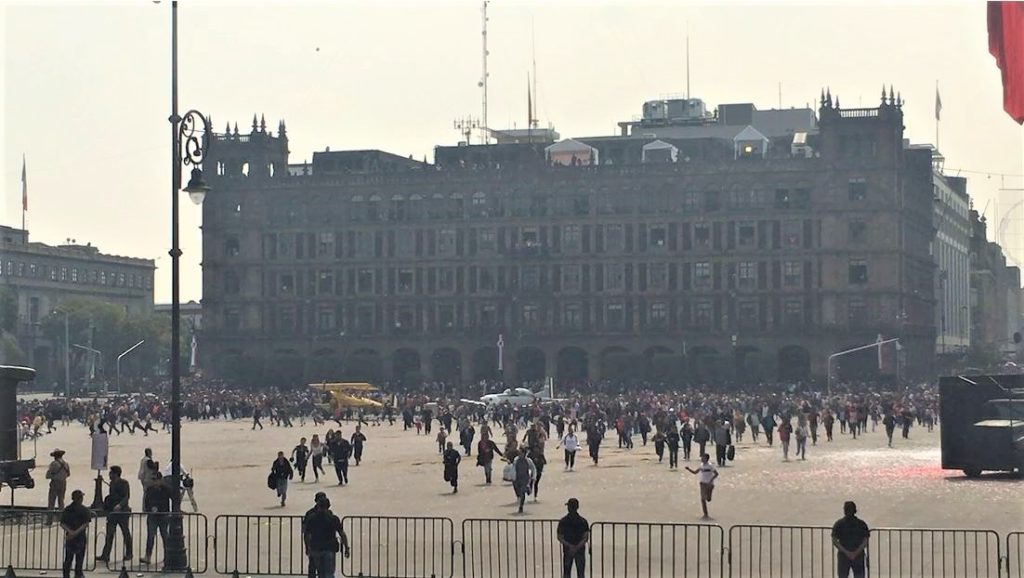
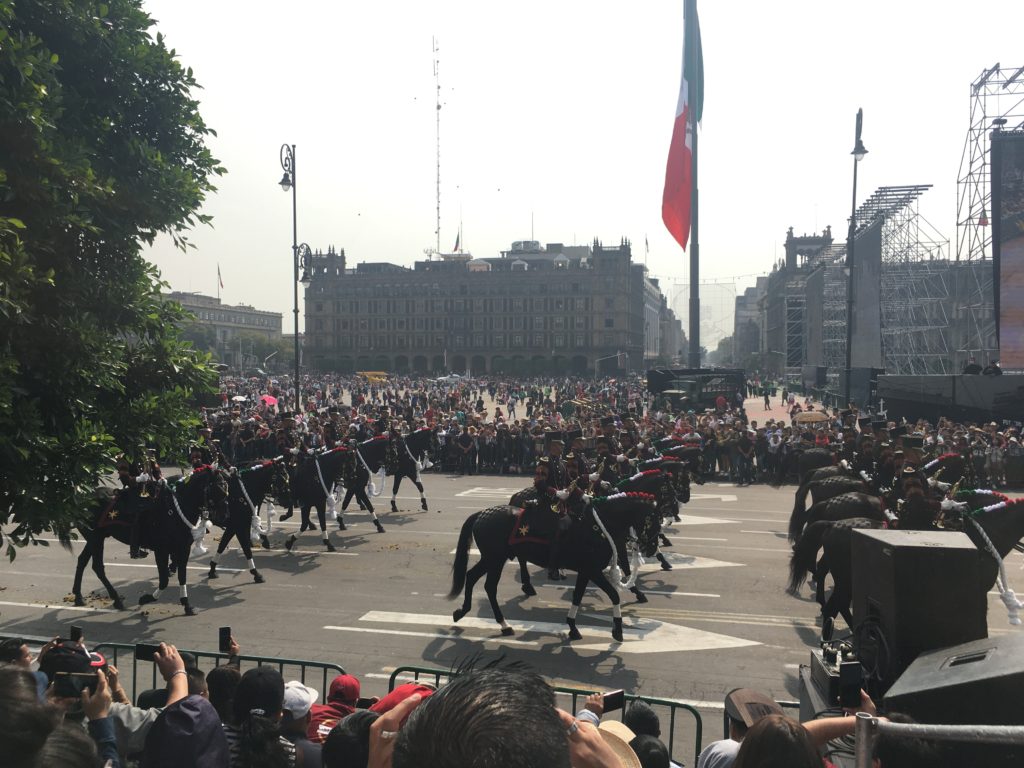
That’s all I have! I hope this helps you to prepare for El Día de la Revolución in Mexico City!
If you have any questions or comments, feel free to contact us at hello@DangGoodLife.com.
If this article has helped you to plan your own adventure in Mexico City, please consider supporting us by shopping through our affiliate links, sharing this post, and engaging with us on our social media channels. Your support helps us keep gas in the van so that we can continue to provide this Dang Good content.
With sincere gratitude,
Lien & Jon
